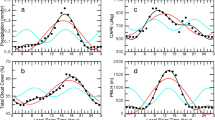Abstract
This paper presents a brief description of the General Circulation Model of the lower and middle atmosphere of the Earth, which is designed to study atmospheric dynamics in a wide range of spatial-temporal scales. The model is based on numerical integration of the complete system of equations that describe the dynamics of a viscous atmospheric gas using a spatial grid with a high resolution. The model takes into account the surface relief and the presence of atmosphere aerosols in the form of microdroplets of water ice particles, as well as the phase transitions of water vapor to aerosol particles and back.
Similar content being viewed by others
References
A. S. Monin, Theoretical Principles of Geophysical Hydrodynamics (Gidrometeoizdat, Leningrad, 1988) [in Russian].
L. J. Donner et al., “The dynamical core, physical parameterizations, and basic simulation characteristics of the atmospheric component AM3 of the GFDL global coupled model CM3,” J. Clim. 24, 3438–3519 (2011).
G. S. Rivin et al., “The COSMO-ru system of nonhydrostatic mesoscale short-range weather forecasting of the hydrometcenter of Russia: the second stage of implementation and development,” Russ. Meteorol. Hydrol. 49, 400–410 (2015).
V. P. Dymnikov, V. N. Lykosov, and E. M. Volodin, “Problems of modeling climate and climate change,” Izv., Atmos. Ocean. Phys. 42, 568–586 (2006).
V. N. Lykosov et al., Supercomputer Modeling in Climate System Physics (Mosk. Gos. Univ., Moscow, 2012) [in Russian].
B. N. Chetverushkin and E. V. Shilnikov, “Software package for 3D viscous gas flow simulation on multiprocessor computer systems,” Comput. Math. Math. Phys. 48, 295–305 (2008).
O. M. Belotserkovskii, A. M. Oparin, I. V. Mingalev, V. S. Mingalev, O. V. Mingalev, and V. M. Chechetkin, “Formation of large-scale vortices in shear flows of the lower atmosphere of the Earth in the region of tropical latitudes,” Cosm. Res. 47, 446–479 (2009).
I. V. Mingalev, K. G. Orlov, and V. S. Mingalev, “The mechanism of formation of polar cyclones and possibility their predictions by using satellite observation data,” Sovrem. Probl. Distants. Zondir. Zemli Kosmosa 8 (1), 255–262 (2011).
I. V. Mingalev, N. M. Astaf’eva, K. G. Orlov, V. S. Mingalev, O. V. Mingalev, and V. M. Chechetkin, “Possibility of a detection of tropical cyclones and hurricanes formation according to satellite remote sensing,” Sovrem. Probl. Distants. Zondir. Zemli Kosmosa 8 (3), 290–296 (2011).
I. V. Mingalev, K. G. Orlov, and V. S. Mingalev, “A mechanism of formation of polar cyclones and possibility of their prediction using satellite observations,” Cosm. Res. 50, 160–169 (2012).
I. V. Mingalev, K. G. Orlov, V. S. Mingalev, O. V. Mingalev, N. M. Astaf’eva, and V. M. Chechetkin, “Numerical simulation of formation of cyclone vortex flows in the intratropical zone of convergence and their early detection,” Cosm. Res. 50, 233–248 (2012).
I. V. Mingalev, N. M. Astafieva, K. G. Orlov, V. S. Mingalev, O. V. Mingalev, and V. M. Chechetkin, “A simulation study of the formation of large-scale cyclonic and anticyclonic vortices in the vicinity of the intertropical convergence zone,” ISRN Geophys. 2013, 215362(2013).
I. Mingalev, K. Orlov, and V. Mingalev, “A modeling study of the initial formation of polar lows in the vicinity of the arctic front,” Adv. Meteorol. 2014, 970547(2014).
I. V. Mingalev, N. M. Astafieva, K. G. Orlov, V. S. Mingalev, O. V. Mingalev, and V. M. Chechetkin, “Numerical modeling of the initial formation of cyclonic vortices at tropical latitudes,” Atmos. Clim. Sci. 4, 899–906 (2014).
A. M. Obukhov, Turbulence and Dynamics of the Atmosphere (Gidrometeoizdat, Leningrad, 1988) [in Russian].
P. C. Reist, Introduction to Aerosol Science (Macmillan, London, New York, 1984).
B. N. Chetverushkin, Mathematical Modeling of Problems in the Dynamics of Radiating Gas (Nauka, Moscow, 1985) [in Russian].
B. A. Fomin, “A k-distribution technique for radiative transfer simulation in inhomogeneous atmosphere: 1. FKDM, fast k-distribution model for the longwave,” J. Geophys. Res. 109, D02110 (2004). doi 10.1029/ 2003JD003802
B. A. Fomin and M. P. Correa, “A k-distribution technique for radiative transfer simulation in inhomogeneous atmosphere: 2. FKDM, fast k-distribution model for the shortwave,” J. Geophys. Res. 110, D02106 (2005). doi 10.1029/2004JD005163
A. V. Shilkov and M. N. Gerthev, “Verification of the Lebesgue averaging method,” Math. Models Comput. Simul. 8, 93–107 (2016).
V. S. Mingalev, I. V. Mingalev, O. V. Mingalev, A. M. Oparin, and K. G. Orlov, “Generalization of the hybrid monotone second-order finite difference scheme for gas dynamics equations to the case of unstructured 3D grid,” Comput. Math. Math. Phys. 50, 877–899 (2010). doi 10.1134/S0965542510050118
V. A. Bakhtin, V. A. Kryukov, B. N. Chetverushkin, and E. V. Shil’nikov, “Extension of the DVM parallel programming model for clusters with heterogeneous nodes,” Dokl. Math. 84, 879–881 (2011).
J. M. Picone, A. E. Hedin, D. P. Drob, and A. C. Aikin, “NRLMSISE-00 empirical model of the atmosphere: statistical comparisons and scientific issues,” J. Geophys. Res. 107 (A12), 1468–1483 (2002).
Author information
Authors and Affiliations
Corresponding author
Additional information
Original Russian Text © B.N. Chetverushkin, I.V. Mingalev, K.G. Orlov, V.M. Chechetkin, V.S. Mingalev, O.V. Mingalev, 2017, published in Matematicheskoe Modelirovanie, 2017, Vol. 29, No. 8, pp. 59–73.
Rights and permissions
About this article
Cite this article
Chetverushkina, B.N., Mingalev, I.V., Orlov, K.G. et al. Gas-Dynamic General Circulation Model of the Lower and Middle Atmosphere of the Earth. Math Models Comput Simul 10, 176–185 (2018). https://doi.org/10.1134/S2070048218020047
Received:
Published:
Issue Date:
DOI: https://doi.org/10.1134/S2070048218020047




